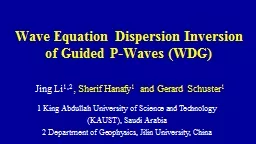

Jing Li 12 Sherif Hanafy 1 and Gerard Schuster 1 1 King Abdullah University of Science and Technology KAUST Saudi Arabia 2 Department of Geophysics Jilin University China ID: 779871
Download The PPT/PDF document "Wave Equation Dispersion Inversion of Gu..." is the property of its rightful owner. Permission is granted to download and print the materials on this web site for personal, non-commercial use only, and to display it on your personal computer provided you do not modify the materials and that you retain all copyright notices contained in the materials. By downloading content from our website, you accept the terms of this agreement.
Slide1
Wave Equation Dispersion Inversion of Guided P-Waves (WDG)
Jing Li1,2, Sherif Hanafy1 and Gerard Schuster1
1
King
Abdullah
University
of Science and Technology
(
KAUST), Saudi Arabia
2 Department of Geophysics, Jilin University, China
Slide2MotivationGuided-wave Inversion TheoryResults
Synthetic and Field DataConclusions and Limitation Outline
WDG Tomogram
WDG P-velocity Tomogram
GW
Shot Gather
Slide3Challenge: 1) Inverted accurate velocity model and 2) Statics correctionSolution: W
ave-equation dispersion inversion for Guided-waves (WDG) Motivation
Stack
with static from high resolution velocity
Stack
with static from inaccurate velocity
(Florian
Duret
, et al, 2016, TLE}
Problem:
Traveltime
velocity tomogram has low
resolution and inaccurate
.
Slide4P-wave reverberations
Snapshots of
wavefield
(
Mi
, et al, 2018; LVL
: low velocity layer)
If there is great velocity difference, P-wave will be trapped
in the low velocity
layer (
Grant and
West, 1965)
Shot Gather
Guided-waves
Background for Guided Waves
No Guided waves
Slide5Different kinds of Guided-waves (Boiero, TLE, 2013).
Ocean Bottom Cable (OBC) dataTowed-streamer
Land Seismic data
f
(Hz)
k
(1/m)
f
(Hz)
k
(1/m)
Background for Guided Waves
f
(Hz)
k
(1/m)
Slide6MotivationsGuided-wave Inversion TheoryResults
Synthetic and Field DataConclusions and LimitationOutline
Predicted
Observed
Frequency (Hz)
Dispersion Curves
v (m/s)
Slide71)
Misfit Function Source field
Backpropagated
field
2) Gradient
3) Velocity Update
Guided-wave Inversion Theory
(WDG)
Dispersion Curves
f (Hz)
c (m/s)
Slide8Wave-equation Traveltime Inversion (WT) vs Wave-equation Dispersion Inversion for
Guided-waves (WDG)Wave-equation traveltime tomography (Luo and Schuster, 1991)Wave-equation dispersion tomography (Li and Schuster
,
2018
)
Properties:
Misfit function:
Gradient:
Predicted
Observed
Frequency (Hz)
Wavenumber (m-1)
Frechet
derivative
Slide9Steepest descentInverted Vp
0 x (m) 120 0 10z (m)
WDG
Workflow
True
Vp
Model
0 x (m) 120
0
10z (m)Initial Vp Model
0 x (m) 120
0
10
z (m)
Obs. Dispersion
f (Hz)
v (m/s)
Pred. Dispersion
f (Hz)
v (m/s)
Radon Transform
Residual Dispersion
f (Hz)
k (m-1)
Backpropagated
Data
0 x (m) 120 0 0.5 t (s)WeightedUpdate
0 x (m) 120 0 10z (m)GradientRTMds=ds-alpha*(de\ds)
Slide10MotivationGuided-wave Inversion TheoryResults
Synthetic and Field DataConclusions and LimitationOutline
WDG Tomogram
WDG P-velocity Tomogram
Slide11True P-velocity Model
0
5
10
15
20
0 x (m) 120
z (m)
2500
2000
1500
1000
m/s
WT vs WDG
WT Tomogram
WDG Tomogram
Parameter:
V1=1000 m/s V2=2500 m/s.
f=40 Hz,
λ=25
m
Sr
=30,
Re=60;
Initial P-velocity
Model
λ/2=12.5m
Slide12Synthetic Model TestParameter: V1=1000 m/s V2=2500 m/s.
f=40 Hz, λ=25 m Sr=60, Re=120; 0 10
20
True
P-velocity Model
z (m)
WDG P-velocity
Tomogram
0
10
20
0 60 120 180 240
z (m)
Initial P-velocity
Model
λ/2=12.5m
2500
2000
1500
1000
0
10
20
z (m)
m/s
Slide13Seismic - Parameter
Equipment: Geometrics No of Profiles: 2No. of shots: 120Shot Interval: 5 mNo. of Receivers: 240Receiver Interval: 2.5 mProfile Length: 600
m
Qademah
Field Data Test
(
Sherif
, et al, 2012)
Slide14Radon Transform
Raw Shot Gather
t (s)
x (m)
Adaptive window mute
Dispersion Curves
V (m/s)
f (Hz)
Qademah
Field Data Test
Window
Guided-waves
t (s)
x (m)
Slide15Qademah
Data P-velocity Tomogram 0 40
WT Tomogram
z (m)
3.0
2.2
1.6
1.0
km/s
0
40
z (m)
WDG Tomogram
3.0
2.2
1.6
1.0
km/s
0 600
x (m)
Slide16WDG and WT Common Offset Gather (Offset=40 m)
T (s)
Raw Data COG
0
0.4
WDG Inverted Data COG
0
600
0
0.4
T (s)
Slide17WDG and WT Common Offset Gather (Offset=40 m)
T (s)
Raw Data COG
0
0.4
WT Inverted Data COG
0
600
0
0.4
T (s)
Slide180 0.250 200t (s)
Offset (m)
Raw Data
WT Data
Qademah
Field
CSG Trace
Comparison
Slide190 0.25
0 200
t (s)
Offset (m)
Raw Data
WDG Data
Qademah
Field
CSG Trace
Comparison
Slide20MotivationGuided-wave Inversion TheoryResults
Synthetic and Field DataConclusions and LimitationOutline
Slide21Conclusions1. Guided-waves dispersion inversion (WDG) can accurately reconstruct the
P-velocity in near surface structure. WT
WT Tomogram
Z (m)
x (m)
Dispersion Curve
V (m/s)
f
(Hz)
Radon
Transform
Traveltime
map
Rec.
Source
Pick
WDG
WDG Tomogram
Z (m)
x (m)
Shot Gather
t (s)
x (m)
Shot Gather
t (s)
x (m)
GW
Slide22Conclusions2. WDG tomogram has higher (?) resolution than WT.
WT Tomogram
WDG Tomogram
True P-velocity Model
0
20
0
120
z (m)
x
(m)
2500
2000
1500
1000
m/s
Slide23Limitation
Shot Gather
z (m)
z (m
)
z (m)
V1=1000 m/s
V2=1400 m/s
True
Vp
Model
WDG Tomogram
V1=1000 m/s
V2=2500
m/s
1. WDG not always visible
2. Poor quality dispersion curves
3. Multiscale strategy
Slide24AcknowledgementsSponsors of the CSIM (csim.kaust.edu.sa) consortium.KAUST Supercomputing Laboratory (KSL) and IT research computing group.
Slide25Thank you